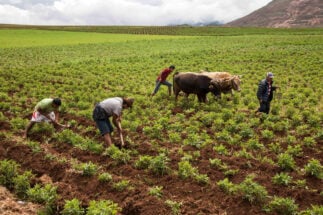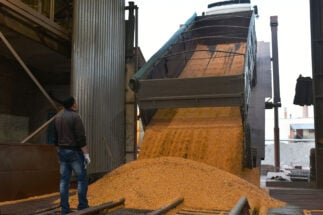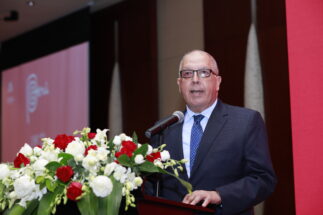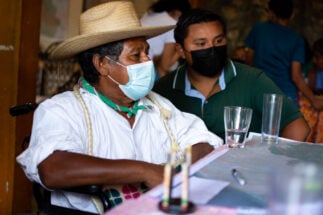A recent survey by Peru’s Ministry of Agrarian Development and Irrigation indicated that some 20,000 hectares of rice, potatoes and onions will no longer be sown next season, with the country’s small- and medium-scale farmers hard hit by the tightening global fertiliser crisis. According to Peru’s 2019 National Agricultural Survey, there are just over 2.4 million farmers active at such scales in the country, of whom almost half (46.7%) use chemical fertilisers.
“We estimate that production will fall because fertiliser prices have risen by almost 300%,” Ángel Misayuri, president of the Junín Agricultural Producers’ Defence Front, told Diálogo Chino. “Before, urea fertiliser cost US$15 a sack, now it is reaching US$58.” He also complained of a lack of support for the sector from President Pedro Castillo, the leader who had proven popular with rural voters, and who only last year announced a programme of agrarian reform in an attempt to boost the sector.
The president, Miyasuri said, has not made satisfactory decisions to solve the fertiliser issue, which is worsening for a number of reasons. The cost of gas – the raw material used in urea production – has increased globally since 2021, while high international shipping rates and the escalation of tensions between Russia and Ukraine have also impacted on imports, as the UN’s Food and Agriculture Organization highlights. Additionally, rises in the price of coal in China have led to a reduction in fertiliser production and, consequently, restrictions on its export. All these external factors, coupled with Peru’s own political instability, have made the outlook for the country increasingly bleak.
Urea not arriving
In the face of restrictions from Russia and China, urea imports into Peru have fallen by 58% compared to the average of the last seven years, according to agriculture ministry figures.
The third call, meanwhile, came under serious scrutiny from the Comptroller’s Office, the authority that supervises use of state assets. The issues raised forced the state to disqualify the winning company, the US firm Ready Oil Supply, and award the contract to Union Sped, of Italy. The company, however, has still has not signed a contract and, according to experts, will not be able to deliver the 65,000 tonnes that are due in September.
Amid these difficulties, there are around 950,000 producers and 1.7 million hectares dependent on – and awaiting – chemical fertilisation in Peru, according to an analysis by Miguel Pintado, an economist from the Peruvian Centre for Social Studies (CEPES). The researcher also points out that rice, maize and potato show a very high dependence on fertilisation, with over 50% of producers reliant on chemical supplements.
Laureano del Castillo, executive director of CEPES, told Diálogo Chino that, similar to its purchases of urea, the government has not been clear about the measures that will be applied for its distribution. The producers registered in the government’s Agricultural Producers Register already number 563,000 and continue to increase, and experts point to the need for new purchases to satisfy the current crop. “There is a possible scenario in which there will be a reduction in the harvest due to limited access to fertiliser,” said Del Castillo. The result, he says, would be reduced food supply and higher prices, and this would particularly affect poor families who spend more of their income on food.
There is a possible scenario in which there will be a reduction in the harvest due to limited access to fertiliser
Data from ENIS, a government-run national database that records farmer’s planting intentions and provides forecasting information to guide them, indicates an overall growth in planted area of 4% for the 2022-23 cycle, compared to the average of the last five crop years. Despite this, a reduction is expected in the production of rice and potatoes, important staples in the Peruvian diet, and which represent 23% of the gross value of agricultural production.
Forecasts for next year project a fall in potato production of 10.7%, some 620,873 tonnes less than in 2022, while rice production could fall by 7.5%.
This decrease is largely driven by the increase in the prices of chemical fertilisers that increase the cost of crops and capitalisation of small farmers, said Rigoberto Coico, director of the General Directorate of Agrarian Policies (DGPA) of the Ministry of Agrarian Development and Irrigation.
Chinese exports in the spotlight
With China one of the world’s main exporters of chemical fertilisers, high energy costs, lower domestic production and restrictions set by its National Development and Reform Commission on exports have had global effects.
Surveys of fertiliser importing companies conducted by Peru’s Central Reserve Bank (BCR) reported an increase in imports from China, although respondents informed of a delivery time of 90 days from the time they leave the Asian country. These long delays, as mentioned by the BCR in its report, are causing businessmen to start evaluating other markets, such as Algeria, Bolivia and Indonesia.
Peru acquired the majority of its main fertilisers used in 2021 from China, according to figures from the National Superintendence of Customs and Tax Administration (SUNAT). This included: 87,000 tonnes of urea, or 26.7% of Peru’s total urea imports; 48.7% (some 124,800 tonnes) of its ammonium sulphate imports; and 41.1% (52,200 tonnes) of its ammonium phosphate imports.
Organic alternatives
This difficult situation has led to the development of alternative approaches to securing harvests. Recently, in an effort to increase domestic production, Peru’s agriculture ministry announced the creation of the National Association of Organic Fertiliser and Fertiliser Manufacturers (GRENFAFO), with a potential monthly output of more than 58,000 tonnes of solid organic fertilisers and over 1.2 million litres of liquid organic fertilisers.
Martín Valdivia, coordinator of GRENFAFO, told Diálogo Chino that the advantage of these fertilisers is that they can be reformulated depending on the type of crop being cultivated.
“The results have been favourable for the planting of fruit trees, avocado, potatoes, rice and maize, for example. We have a viable, domestic alternative, without the need to depend on conditions outside the country [given the dependence on urea]. We’re talking about changing a decades-old mindset around the use of chemical fertilisers,” Valdivia said.
Although farmers in some regions of southern Peru have been implementing these practices, Valdivia admits that there is a lack of awareness of their use, adding that the Ministry of Agrarian Development and Irrigation, which once supported farmers, is now not responding to their requests.

On the other hand, a campaign for the use of guano as fertiliser, collected from the islands off the Peruvian coast and rich in nutrients, aims to extract a total of 102,000 tonnes of guano nationally this year, which would benefit around 150,000 farmers. Guano is currently being collected from islands off the coastal regions of La Libertad, Lambayeque and Piura, in the country’s north. Its collection and commercialisation is the responsibility of Agro Rural, and is mainly aimed at satisfying the demand of Peruvian producers who manage up to 10 hectares of land.
“There is an opportunity to promote the use of organic fertilisers and cover part of the demand, but more support is needed,” Eduardo Zegarra, a specialist in agrarian issues and a member of the GRADE research centre, told Diálogo Chino. “If we don’t want to depend on imports of chemical fertilisers, we should have production plants, which we could have because we produce inputs such as gas – the basis for urea – and phosphates. It should be a government policy.”
At the height of the fertiliser hike, the former head of the agriculture ministry, Óscar Zea, announced that his office had held meetings with businessmen from China and South Korea to establish a domestic chemical fertiliser plant within two years. Five months since, and no further developments have arrived.
“It’s a crisis that hits us, but one that raises possibilities. In the long term, this technological, productive and economic dependence [on chemical fertilisers] could be eliminated,” adds Laureano del Castillo, adding that, despite the setbacks, he hopes that the country’s 2 million-plus smaller scale farmers will be able to pull through this difficult period.









